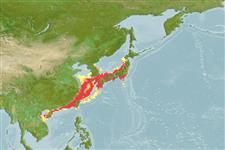>
Perciformes/Scorpaenoidei (Scorpionfishes) >
Triglidae (Searobins) > Triglinae
Etymology: Lepidotrigla: Greek, lepis, lepidos = scale + Greek, trigla, es = red mullet (Ref. 45335).
Eponymy: Kamakichi Kishinouye (1867–1929) was a fisheries biologist at Tokyo Imperial University, where he was a professor in the Faculty of Agriculture. [...] (Ref. 128868), visit book page.
More on author: Snyder.
Environment: milieu / climate zone / गहराई सीमा / distribution range
पारिस्थितिकी
समुद्री ड़िमरसल; गहराई सीमा 40 - 140 m (Ref. 11230). Temperate
Northwest Pacific: southern Japan and the East China Sea.
आकार / वज़न / Age
परिपक्व अवधि: Lm ? range ? - ? cm
Max length : 20.0 cm TL पुल्लिंग / अलिंग; (Ref. 559)
Inhabits sandy-mud bottoms.
Life cycle and mating behavior
परिपक्व अवधि | पुनरुत्पत्ति | मछलीऔ का अंडे देना | अंडे | Fecundity | लार्वा
Yamada, U., S. Shirai, T. Irie, M. Tokimura, S. Deng, Y. Zheng, C. Li, Y.U. Kim and Y.S. Kim, 1995. Names and illustrations of fishes from the East China Sea and the Yellow Sea. Overseas Fishery Cooperation Foundation, Tokyo, Japan. 288 p. (Ref. 11230)
IUCN Red List Status (Ref. 130435: Version 2025-1)
Threat to humans
Harmless
Human uses
मात्स्यिकी: कोई रुचि बग़ैर
साधन
Special reports
Download XML
इंटरनेट स्रोत
Estimates based on models
Preferred temperature (संदर्भ
123201): 15.7 - 23.6, mean 20.3 °C (based on 64 cells).
Phylogenetic diversity index (संदर्भ
82804): PD
50 = 0.5000 [Uniqueness, from 0.5 = low to 2.0 = high].
Bayesian length-weight: a=0.00631 (0.00369 - 0.01080), b=3.01 (2.86 - 3.16), in cm total length, based on LWR estimates for this species & (Sub)family-body (Ref.
93245).
Trophic level (संदर्भ
69278): 3.5 ±0.3 se; based on size and trophs of closest relatives
लौटाव (संदर्भ
120179): माध्यम, न्यूनतम जनसंख्या दुगनी होने का समय 1.4 - 4.4 वर्ष। (Preliminary K or Fecundity.).
Fishing Vulnerability (Ref.
59153): Low vulnerability (10 of 100).
🛈
